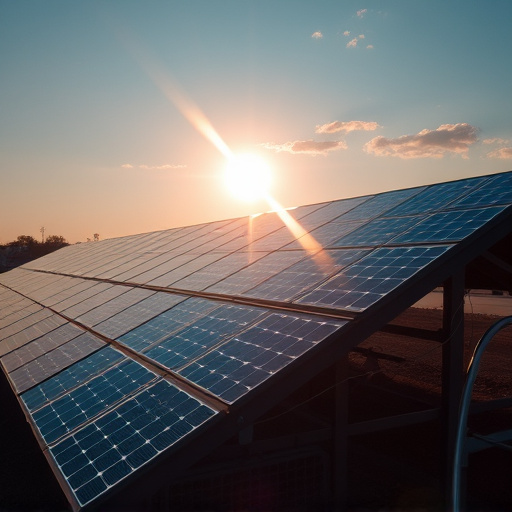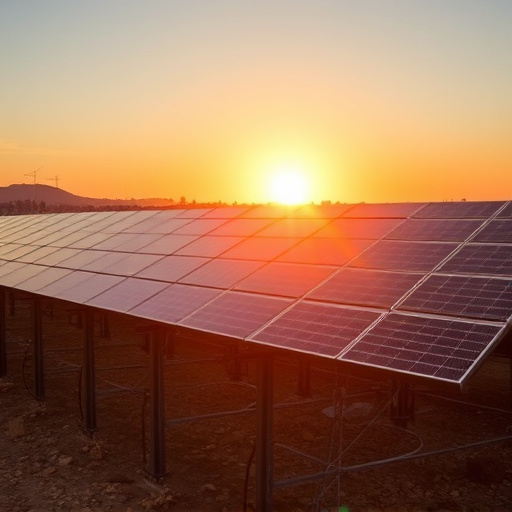Solar shingles represent a groundbreaking fusion of renewable energy and roofing technology, providing an aesthetically pleasing, durable, and efficient alternative to conventional materials. These innovative products integrate photovoltaic (PV) cells that harness sunlight, converting it into direct current (DC) electricity, which can be used or stored. By distributing PV cells across the roof, solar shingles offer optimal sunlight capture, significant energy cost savings, and reduced carbon footprints. With improved durability and weather resistance, they enhance property value while contributing to environmental conservation and mitigating climate change impacts. Proper installation techniques, focusing on visual harmony with conventional roofing aesthetics, are essential for creating an indelible fusion of Solar Power technology.
“Discover the future of roofing with solar shingles—a seamless fusion of traditional aesthetics and renewable energy. This innovative technology offers more than just aesthetic appeal; it’s a powerful way to generate clean energy for your home.
In this article, we explore the benefits and design aspects of integrating solar power into your roofing system. From understanding how solar shingles work to the advantages they bring, you’ll uncover why this is a growing trend in sustainable living.”
- Understanding Solar Shingles and Their Functionality
- Benefits of Integrating Solar Power into Traditional Roofing
- Design Considerations for a Seamless Blend
Understanding Solar Shingles and Their Functionality

Solar shingles are a cutting-edge innovation in renewable energy, seamlessly integrating solar power generation with traditional roofing materials. These advanced shingles are designed to look identical to conventional asphalt shingles while capturing sunlight and converting it into electricity. Underneath their aesthetically pleasing exterior lies a complex system of photovoltaic (PV) cells, which absorb photons from the sun, generating direct current (DC) electricity. This DC power is then sent through wiring integrated into the shingle system, allowing it to be connected to your home’s electrical panel for use or storage.
The functionality of solar shingles goes beyond their aesthetic appeal and contribution to a greener environment. They offer a more efficient way to harness solar power by distributing the photovoltaic cells across the entire roof surface, maximizing sunlight exposure. This distributed generation approach not only enhances energy efficiency but also reduces the overall cost of installing solar panels, making clean energy more accessible to homeowners. With advancements in technology, solar shingles are becoming increasingly durable and weather-resistant, ensuring long-term performance while providing an eco-friendly alternative to traditional roofing solutions.
Benefits of Integrating Solar Power into Traditional Roofing

Integrating solar power into traditional roofing offers a plethora of benefits, making it an increasingly popular choice for homeowners and businesses alike. One of the key advantages is the significant reduction in energy costs. Solar shingles act as a sustainable and cost-effective alternative to conventional roofing materials, allowing you to harness the power of the sun to generate electricity. This not only diminishes your reliance on traditional energy sources but also results in substantial savings on your utility bills over time.
Moreover, solar roofs contribute to environmental conservation by reducing carbon footprints. They provide a clean and renewable energy solution, helping to mitigate the impact of climate change. With advancements in technology, solar shingles are now more aesthetically pleasing and durable than ever, seamlessly blending with traditional roofing styles while providing long-lasting performance and increased property value.
Design Considerations for a Seamless Blend

When integrating solar shingles into a traditional roofing design, careful consideration is required to achieve a seamless blend that enhances the overall aesthetic appeal. The key lies in aligning the look and feel of the solar panels with the existing roof structure. Architects and homeowners should opt for solar shingles that closely mimic the color, texture, and shape of standard roofing materials like asphalt or slate. This ensures the solar panels become an invisible addition to the roof, blending in seamlessly without compromising visual harmony.
Furthermore, proper installation techniques are vital. The solar shingles should be arranged in a way that mirrors the natural patterns of traditional roofing, whether it’s the random layering of shingles or the uniform rows often seen on pitched roofs. Skilled installers can achieve this by following the roof’s contour and ensuring the solar panels are securely fastened, creating an indelible fusion of Solar Power technology and conventional roofing aesthetics.
Solar shingles offer an innovative way to harness solar power while seamlessly integrating with traditional roofing. By understanding their functionality and design considerations, homeowners can enjoy the numerous benefits of solar energy, including reduced electricity bills and a smaller environmental footprint. Embracing this technology is not just a step towards a greener future but also a practical decision that could save you money in the long run. So, why wait? Dive into the world of solar shingles to revolutionize your roofing game.
